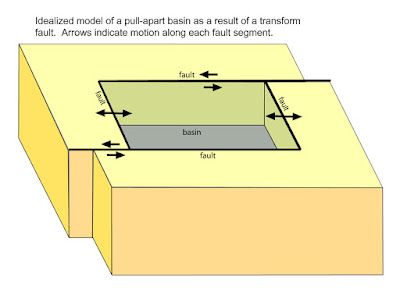The formation of the Dead Sea is caused by a plate interaction
between the Arabian plate and the African-Sinai plate. The interaction between
those two plates is also known as the Dead Sea Transform (DST). The DST is a
1000 km continental transform that extends from the Red Sea to the Taurus
Zagros collision zone. The DST is a left-lateral strike-slip fault, therefore the
Arabian plate and the African-Sinai plate interact through a side-by-side
movement. In some areas of the DST, the two plates also pull apart from each other (extension
fault), which is a diverge-plate interaction.
 |
| The African plate is located on the west side of the Dead Sea, while the Arabian plate is located on the east side.This picture gives the overall indication of where the plates transform and diverge. Picture from: https://www.see.leeds.ac.uk/structure/leb/tectonics/regional/regional.htm |
 |
| This image gives a great detailed description of the plate interactions between the Arabian Plate and African Plate such as its location and the direction of its movement. It also shows the location of the Dead Sea along the Dead Sea Transform. Picture from https://thenaturalhistorian.com/2014/09/06/origins-of-the-dead-sea-part-iii-the-levant-a-land-literally-torn-apart/ |
The Dead Sea is located in the southern part of the DST, and the
two fault systems (strike-slip and extension) overlap with each other in this
area. This overlap creates pull-apart basins, which occurs when "two
overlapping faults or a fault bend create an area of crustal extension
undergoing tension that causes the basin to sink down” (7). Thus, the Dead Sea is
none other than a pull-apart basin. The extension fault system is a large
component involved in the creation of the Dead Sea. In other words, the two
plates pull apart from each other creating a down faulted valley (graben),
which is now the Dead Sea.
The extension fault also contributes to the downwards sinking
motion of the Dead Sea. As the Arabian plate and the African-Sinai plate
diverge, the earth’s crust stretches thin. Consequently, the area where the
earth’s crust is thinning starts to sink downwards. Hence, the Dead Sea is located
right where the earth’s crust stretches thin, which causes it to sink. The continuous
fault movements of the DST are moving 5-7 mm per year, and this movement
contributes to the continuous sinking of the Dead Sea. In fact, "scientists
estimate that the Dead Sea is sinking by 13 inches per year" (4).
 |
| This picture shows how a pull-apart basin is formed from a transform fault. The transform fault is shown on the top and the bottom of the diagram, and on the side it shows the extension fault. Picture from: http://woodshole.er.usgs.gov/project-pages/dead_sea/tectonic.html |
 |
| This picture shows the tectonic movements on the left and on the right you can see a focus on the Dead Sea topography. In the right image you can see how the Dead Sea is a valley, as that area sinks downwards between two topographic barriers. Picture from: http://woodshole.er.usgs.gov/project-pages/dead_sea/tectonic.html |
Sources:
- Allen, C. (2016). Lecture 11: Plate Tetonics. Personal Collection of C. Allen, University of Colorado Denver, Denver, CO.
- Allen, C. (2016). Lecture 14: Faults and Folds Part A & B. Personal Collection of C. Allen, University of Colorado Denver, Denver, CO.
- BenAvraham, Z., & Katsman, R. (2015). The formation of graben morphology in the dead sea fault, and its implications: GRABEN MORPHOLOGY IN THE DEAD SEA FAULT. Geophysical Research Letters, 42(17), 6989 6996. doi:10.1002/2015GL065111
- Extreme Science. (n.d). Lowest Elevation: Dead Sea. Retrieved from http://www.extremescience.com/dead-sea.htm
- Klinger, Y., Avouac, J. P., Dorbath, L., Karaki, N. A., & Tisnerat, N. (2000). Seismic behaviour of the dead sea fault along araba valley, jordan. Geophysical Journal International, 142(3), 769-782. doi:10.1046/j.1365-246x.2000.00166.x
- Natural Historian. (2014). Origins of the Dead Sea Part III: The Levant – A Land Literally Torn Apart. Retrieved from https://thenaturalhistorian.com/2014/09/06/origins-of-the-dead-sea-part-iii-the-levant-a-land-literally-torn-apart/
- Wikipedia. (n.d.). Pull-apart basin. Retrieved from https://en.wikipedia.org/wiki/Pull-apart_basin
No comments:
Post a Comment